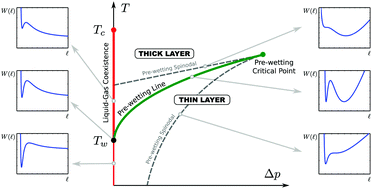First-order wedge wetting revisited
Abstract
We consider a fluid adsorbed in a wedge made from walls that exhibit a first-order wetting transition and revisit the argument as to why and how the pre-filling and pre-wetting coexistence lines merge when the opening angle is increased approaching the planar geometry. We clarify the nature of the possible surface phase diagrams, pointing out the connection with complete pre-wetting, and show that the merging of the coexistence lines lead to new interfacial transitions. These occur along the side walls and are associated with the unbinding of the thin-thick interface, rather than the liquid–gas interface (meniscus), from the wedge apex. When fluctuation effects, together with the influence of dispersion forces are included, these transitions display strong non-universal critical singularities that depend on the opening angle itself. Similar phenomena are also shown to occur for adsorption near an apex tip.



 Please wait while we load your content...
Please wait while we load your content...